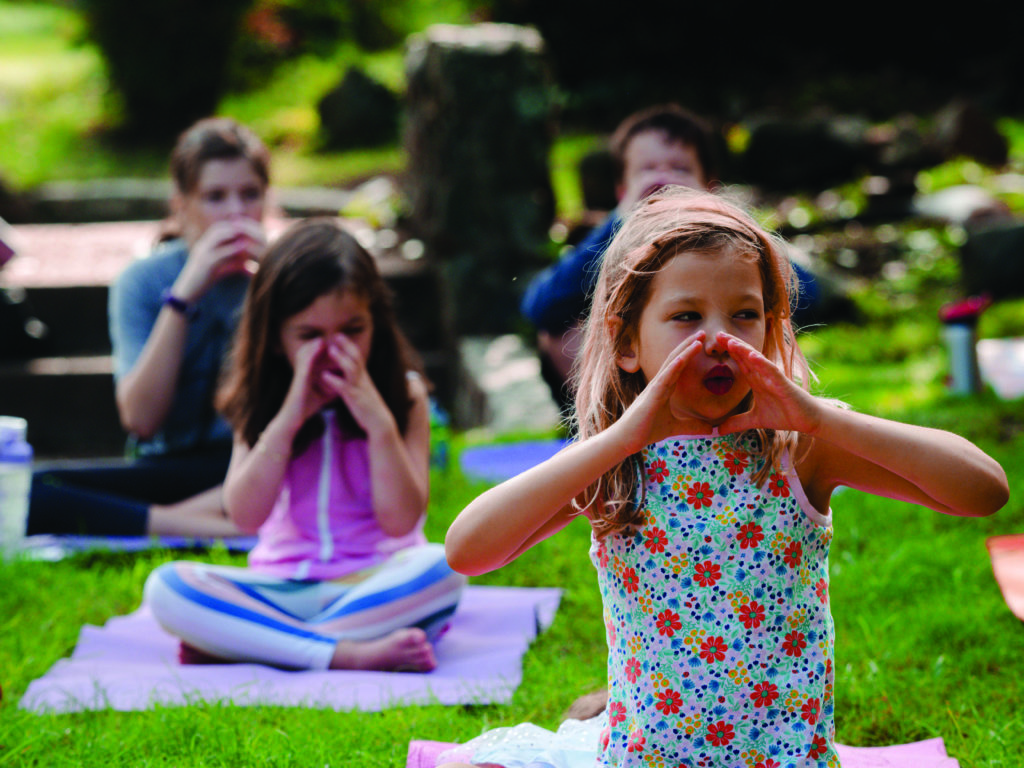By Lauren Lin
Photography by Jessica Whitley
Breathe, just breathe. That phrase, that ideology, is so instinctual. How many times have you heard it spoken, or silently repeated it to yourself on loop? You’ve probably uttered it to a co-worker at one point or another, or calmed a friend with those simple yet reassuring words.
Taking in air is essential to our survival and fuel for our vital organs, but have we ever considered that honing in on this unconscious repetition could harness an incredible power?
Fear, worry, excitement and anticipation — they all require a person to recognize the importance of slowing down, mentally and emotionally, to gain control of thoughts or feelings that have the potential to manifest in a very physical way.
Adults have varied means of processing life and the world around them based on life experience. Children, however, are inherently at a deficit and Maria Andrade is working earnestly to address this.
“Last year, when I was teaching Spanish St. Joseph’s, I lead a yoga cluster and saw first-hand how these children were benefitting from this practice, specifically by focusing on their breathing,” Andrade said. “It really struck me, I became so interested in breath work, specifically directed toward students in the classroom setting — mainly because it calls you to think about all the emotions children have these days, all the problems they experience. Essentially, they come to school with all of these emotions that need to be unpacked at some point because it will manifest in a myriad of ways.”
Andrade’s passion for children is effortlessly evident and that same passion led her to deep dive into this idea of an alternative method to classroom management — mindful breathing. Through conversations with a friend, Andrade discovered Cheryl Crawford with On The Same Breath.
“There are many breathing programs that exist, but I like the concept of her program versus other ones due to its simplicity and because of the connection piece,” Andrade said. “The fact that the breath is what can connect us to ourselves, and then connect to each other; it’s so powerful.”
While exploring breathing practices, Andrade couldn’t help but recognize the symbiotic relationship that existed between what she was learning and the practice of yoga.
It really happened very organically and felt incredibly natural to marry these breathing techniques, this mindful breathing that I was diving into with the practice of yoga. Both are focused on connecting with and to yourself,” said Andrade.
Andrade founded All Bodies Can Breathe (ABCBreathe) after completing the 90-hour curriculum and coursework with On The Same Breath, and fulfilling 95 hours of study for a Registered Children’s Yoga Teacher designation through the Yoga Alliance, the largest nonprofit association representing the yoga community to foster high-quality, safe, accessible and equitable teaching.
“We expect these students or children to just calm down, asking ourselves ‘Why can’t you just focus?’ or ‘Why can’t you just sit still?’ We’re asking all these things from them without actually giving them the resources to do it,” she said. “The same way we wouldn’t expect a first grader to do complicated trigonometry without having taken them through the steps to how to learn how to do that, right? So, part of the emotional intelligence is giving them these tools in their emotional toolbox, these resources to understand their own emotions, so that they can flow through them with a much better understanding.”
Connecting with children
Heather Knowles, a third-grade teacher at St. Joseph’s School, has learned first-hand the benefits of incorporating breathing exercises in the classroom.
“The children (9-year-olds) have embraced breathing techniques in a way I never could have anticipated,” Knowles said. “Not only do we begin our day in a calming and peaceful way, but we are reflecting and developing an emotional skillset to better handle setbacks, anxiety and anger in our everyday lives.”
Science has proven that the act of diaphragmatic breathing reduces stress because the increase of oxygen flow allows for relaxation.
“We don’t think about it, but our breath tells us so much about ourselves and how we’re feeling because the older we get, we lose that connection,” Andrade said. “There are so many things happening around us, and ironically, we talk about it in terms of metaphors, such as ‘I’m so busy I can’t breathe,’ or, ‘I’m feeling underwater right now.’ In just four minutes, we’re teaching these children to find that pause and find that space to listen to how they’re feeling and what emotions come up, then they can make a choice how to react to it.”
The response has been resoundingly positive from students and parents, both of whom believe they have truly tapped into something that has left a lasting impression.

Amy Tarpley, mother of St. Joseph’s School student Brenna, has seen the impact of ABCBreathe and said she couldn’t be more thrilled with its results.
“I love that our school has implemented this program and recognizes the importance of teaching children to be mindful. We have so many distractions in our day-to-day lives and the practice of mindfulness is essential to move past the distractions and live our best lives,” Tarpley said. “The mindful breathing exercises have been really beneficial in our home. … Having these tools in our toolbox to help Brenna get through stressful situations has been really amazing.”
What’s even more intriguing about this entire practice is the emotional awareness students are tapping into. Lily Kate Wilkins, age 10, articulately expresses the change ABCBreathe has made in her life.
“I’m able to think more clearly and be brave about my emotions,” she said. “I feel like I’ve unlocked a different part of myself and am able to help others do the same. I know that ‘I am ready, I am steady, I am clear, I have no fear.’”
Access is key when it comes to the use of these practices, which is why Andrade is working earnestly to make mindful breathing available to anyone regardless of ethnicity, gender or socioeconomic status.
“I know that there’s a stigma that can be associated with the practice of yoga, with breathing techniques, and I want to curb that completely. My priority is to help others by means of breathing, something that anyone can harness and grow from,” Andrade said.
Pace Center for Girls, a nonprofit that provides free therapeutic support to girls ages 11-17 in the Macon-Bibb County school district and the Regional Youth Detention Center (RYDC), is in the midst of implementing mindful breathing in addition to individual counseling sessions, group and monthly family sessions they currently provide.
“Many of the girls Pace serves struggle with impulse control. This combined with adverse childhood experiences and negative environmental factors can result in a girl engaging in self-destructive behavior,” said Rebecca H. Richard, LMSW, ASWB, Reach Program Manager for Pace. “These breathing exercises foster a deeper sense of self-awareness, and can be useful when managing anger and anxiety. Breathing exercises such as these will empower and equip girls with tools they can use to deescalate themselves when faced with internal and external conflict.
“The human brain isn’t fully formed until a person is about 25 years old and the prefrontal cortex is the last to fully develop. This part of the brain responds to situations with good judgment, impulse control and an awareness of consequences. Teens process information with the amygdala, the emotional part. In teens’ brains, the connections between the emotional part of the brain and the decision-making center are still developing. Their feelings and thinking are not yet in sync, making the emotional awareness of mindful breathing incredibly poignant and effective.”
In East Macon, Northeast High School has two advisement periods each week, one that focuses on academic enrichment and one centered on social-emotional wellness. “Raidervisement,” as coined by the school, spends time each week delving into Franklin Covey’s “7 Habits of Highly Effective People.”
“We’re always working to be trauma sensitive,” said Northeast Principal Steven Jones. “There are innately many things that weigh all of us down, traumas that exist both on and beneath the surface. We want to help our students and staff identify these stressors, this trauma, and utilize their learned tools and resources to acknowledge and cope with those issues. Mindful breathing is just that, becoming emotionally aware. Our Student Lighthouse Team will become trained to lead this practice as well as promote the movement and excite their classmates about this new initiative.”
Transitioning with the times
While the momentum of ABCBreathe was undoubtedly strong in 2019 and Andrade was gearing up to bring her program to a slurry of new schools this fall, COVID-19 pivoted those plans.
“Now more than ever, the teachings and practices of ABCBreathe are essential to all of us, not just children. Everyone is dealing with the trauma of our current climate and therefore it’s essential to possess the tools to navigate our emotions,” said Andrade, who seems to have taken this seismic shift in stride and transitioned accordingly. “We’ve now become entirely virtual for schools by offering an online platform where all our resources are available as videos. Teachers and staff also have access to online training courses so they are confident with implementation. There’s also the option for live instruction. I’m trying to meet the needs of the students and schools in whatever way proves best for them.”
The current pandemic has brought about a cultural shift in education, one that Steven Haberlin, an assistant professor of education at Wesleyan College, believes can be remedied by the exact practices that ABCBreathe tackles head on.
“While the research is still emerging, contemplative practices such as meditation, mindfulness and yoga are showing much promise as implemented in K-12 classrooms. For example, mindfulness can assist teachers in improving focus, improving the classroom climate and becoming more responsive to students’ needs. It can also help students’ readiness to learn, strengthen their focus and concentration and enhance social-emotional learning,” said Haberlin, whose role at Wesleyan is to help prepare future teachers for coping with life inside and outside of the classroom.
“I examine ways to embed contemplative practices, such as mindfulness and meditation, into this preparation, through classroom activities, assignments and projects. This provides education majors with practical self-care, awareness-based techniques but also helps them see how they might share these practices with their students,” Haberlin said. “To help all students, staff and faculty on campus, I established a meditation space in the student center building and also facilitate meditation and online mindfulness workshops.”
Haberlin’s continued research and practical application echoes Andrade’s efforts.
“With the recent pandemic and massive shifts in the education system model, I believe practices like mindfulness, yoga and breath work are more important and relevant than ever. Teachers and students need ways to ground themselves and manage stress and negative emotions,” Haberlin said.
Middle Georgia Regional Educational Services Agency (RESA) began working with Andrade by incorporating mindful breathing into its social and emotional learning series, just as COVID-19 hit in early March.
As stated on its website, RESA serves stakeholders in developing knowledge, skills and best practices in order to build capacity for district effectiveness and school improvement to support student achievement.
“Anxiety, fear and worry was incredibly prevalent in our teachers with the onset of COVID-19. There was such an abrupt shift in instruction and everything being dealt with in the classroom setting was both foreign and uncharted,” said Lara Sims, president, Georgia Association for Positive Behavior Support School Climate Specialist for RESA. “We provided ABCBreathe’s resources online for the teachers in our districts and it was incredibly well received. It was a powerful to witness educators experience the importance of these practices first hand, truly embracing this form of self-management and then actively implementing it for their students. It was such an act of first responder’s mentality, care for yourself first and then aid those in need around you.”
Sims, who has hired Andrade to teach mindful breathing in 10 schools in Middle Georgia, explained how serendipitous the timing was to introduce mindful breathing and the significant impact it has had for RESA staff, teachers and students alike.
“You can’t have self-management without self-awareness and that kind of emotional maturity is difficult for adults, let alone young students who already struggle with being able to articulate how they feel. Teachers have expressed that this drives them to be intentional with their own positive thought and positive self-talk, and therefore they are able to build an environment of social awareness in the classroom, whether that be virtual or in-person,” said Sims.
A national movement
Cities all across the country, both urban and rural, have begun to hone in on mindful breathing.
Misbehaving students at Warner Arts Magnet Elementary School in Nashville, Tenn., are sent to a “BeWell” room in lieu of a typical reprimand. It’s in this room that a yoga-certified teacher assists students in deep breathing exercises in order to check in with themselves and their emotions.
In Grand Blanc, Mich., the school district has incorporated mindful breathing into its curriculum and even gone so far as to have it as a part of the Grand Blanc Schools Strategic Plan for 2018-2023.
Based on the book “My Magic Breath” by Nick Ortner, the Chicago Public Library recently debuted a mindful breathing video online for children ages 4-8. The video is a collaboration between the Chicago Symphony Orchestra, Chicago Children’s Theatre and narrated by Chicago’s First Lady Amy Eshleman.
According to a 2019 report published by researchers at Harvard’s Center for Education Policy Research, mindfulness-based practices have been promoted as a promising way to reduce stress and anxiety in students and improve their academic and behavioral outcomes.

Given the tremendous momentum of mindful breathing from one coast to the other, the work of Andrade and ABCBreathe right here in Macon is truly progressive and timely.
Cheryl Crawford, with On The Same Breath, is transitioning her practice more toward at-home and lifestyle work, and with that, On The Same Breath and ABCBreathe have merged into one program under Andrade’s guidance. After 33 years spearheading On The Same Breath, Crawford said she felt Andrade was the right person to take the lead because of the significant role Andrade has played in moving the initiative forward, and because Macon is “in the heart of Georgia.”
Andrade’s confidence in her practice hasn’t faltered despite the uncertainty and upheaval of routine that is being felt globally.
“The ultimate goal would be to create a society that has better emotional intelligence and awareness, and connection to themselves and each other — to create this generation of children who turn into adults who make decisions based on their emotional awareness and their connection to each other,” Andrade said. “We’re all going through this together. This is hard and the more we move through challenging times, the more we come out better in the end.”
Learn more
ABCBreathe offers yoga classes for youth ranging from ages 3 to 16 at Sparks Yoga. Groups, private lessons and family options are all socially distanced and available outdoors. For more information, visit ABCBreathe.org.
Lotus Breath
Bring your palms together in front of your heart.
Press your pinky sides together, your thumb sides together. Expand the rest of your fingers away from each other to resemble a lotus flower.
Inhale, raise your lotus flower up as you straighten your arms.
Exhale, release your hands out to the sides, keeping your arms straight, then returning hands back to a lotus flower in front of your heart.


